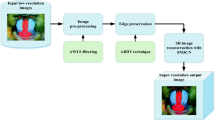Abstract
Advent of convolutional neural network (CNN) in the field of single image super-resolution (SISR) has shown immense improvement in the process of high resolution (HR) image generation. It involves an end-to-end mathematical mapping through non-linear feature extraction between low resolution (LR) and HR image. Performance of CNN can be improved by increasing depth of the architecture, which generally results in higher computational cost and running time. Also, the performance of CNN can be improved by providing more appropriate input. Presently, in most of the cases input image to a CNN is a LR image that is bi-cubically interpolated to the desired size of HR image. However, bicubic interpolation results into detail smoothing of the image. Therefore, in this paper, a hybrid of CNN and fractal interpolation based SISR algorithm is proposed for reconstruction of HR image. Here, a three layered light-weight CNN architecture is utilize which is capable of producing comparable performance with the traditional SISR techniques and fractal interpolation helps in better preservation of structural and textural properties of the HR image. Experimental results are provided to prove the efficacy of the algorithm proposed in the paper.







Similar content being viewed by others
REFERENCES
G. Pandey and U. Ghanekar, “A compendious study of super-resolution techniques by single image,” Optik 166, 147–160 (2018). https://doi.org/10.1016/j.ijleo.2018.03.103
G. Pandey and U. Ghanekar, “Classification of priors and regularization techniques appurtenant to single image super-resolution,” Visual Comput. 36, 1291–1304 (2020). https://doi.org/10.1007/s00371-019-01729-z
H. Chang, D. Y. Yeung, and Y. Xiong, “Super-resolution through neighbor embedding,” in Proceedings of the 2004 IEEE Computer Society Conference on Computer Vision and Pattern Recognition (CVPR 2004) (2004). https://doi.org/10.1109/cvpr.2004.1315043
G. Pandey and U. Ghanekar, “Variance based external dictionary for improved single image super-resolution,” Pattern Recognit. Image Anal. 30 (1), 70–75 (2020). https://doi.org/10.1134/s1054661820010101
J. Yang, J. Wright, T. S. Huang, and Y. Ma, “Image super-resolution via sparse representation,” IEEE Trans. Image Process. 19 (11), 2861–2873 (2010). https://doi.org/10.1109/tip.2010.2050625
R. Timofte, V. De, and L. V. Gool, “Anchored neighborhood regression for fast example-based super-resolution,” in 2013 IEEE International Conference on Computer Vision (2013). https://doi.org/10.1109/iccv.2013.241
J. J. Huang and W. C. Siu, “Learning hierarchical decision trees for single-image super-resolution,” IEEE Trans. Circuit Syst. Video Technol. 27 (5), 937–950 (2017). https://doi.org/10.1109/tcsvt.2015.2513661
C. Dong, C. C. Loy, K. He, and X. Tang, “Image super-resolution using deep convolutional networks,” IEEE Trans. Pattern Anal. Mach. Intell. 38 (2), 295–307 (2016). https://doi.org/10.1109/tpami.2015.2439281
Y. LeCun, Y. Bengio, and G. Hinton, “Deep learning,” Nature 521 (7553), 436–444 (2015). https://doi.org/10.1038/nature14539
J. Kim, J. K. Lee, and K. M. Lee, “Accurate image super-resolution using very deep convolutional networks,” in 2016 IEEE Conference on Computer Vision and Pattern Recognition (CVPR) (2016). https://doi.org/10.1109/cvpr.2016.182
J. Chu, X. Li, J. Zhang, and W. Lu, “Super-resolution using multi-channel merged convolutional network,” Neurocomputing 394, 136–145 (2020). https://doi.org/10.1016/j.neucom.2019.04.089
W. Zhang, Y. Liu, C. Dong, and Y. Qiao, “Ranksrgan: Generative adversarial networks with ranker for image super-resolution” (2019). http://arxiv.org/abs/1908.06382.
P. Shamsolmoali, M. Zareapoor, R. Wang, D. K. Jain, and J. Yang, “G-GANISR: Gradual generative adversarial network for image super resolution,” Neurocomputing 366, 140–153 (2019). https://doi.org/10.1016/j.neucom.2019.07.094
X. Wang, K. Yu, S. Wu, J. Gu, Y. Liu, C. Dong, C. C. Loy, Y. Qiao, and X. Tang, “ESRGAN: Enhanced super-resolution generative adversarial networks” (2018). http://arxiv.org/abs/1809.00219.
M. Haris, G. Shakhnarovich, and N. Ukita, “Deep back-projection networks for super-resolution,” in 2018 IEEE/CVF Conference on Computer Vision and Pattern Recognition (2018). https://doi.org/10.1109/cvpr.2018.00179
Y. Zhang, Y. Tian, Y. Kong, B. Zhong, and Y. Fu, “Residual dense network for image super-resolution” (2018). http://arxiv.org/abs/1802.08797.
D. Lin, G. Xu, W. Xu, Y. Wang, X. Sun, and K. Fu, “SCRSR: An efficient recursive convolutional neural network for fast and accurate image super-resolution,” Neurocomputing 398, 399–407 (2020). https://doi.org/10.1016/j.neucom.2019.02.067
Yunfeng Zhang, Qinglan Fan, Fangxun Bao, Yifang Liu, and Caiming Zhang, “Single-image super-resolution based on rational fractal interpolation,” IEEE Trans. Image Process. 27 (8), 3782–3797 (2018). https://doi.org/10.1109/tip.2018.2826139
A. Krizhevsky, I. Sutskever, and G. E. Hinton, “ImageNet classification with deep convolutional neural networks,” Commun. ACM 60 (6), 84–90 (2017). https://doi.org/10.1145/3065386
Author information
Authors and Affiliations
Corresponding authors
Ethics declarations
The authors declare that they have no conflicts of interest.
Additional information

Garima Pandey completed her B.Tech. in electronics and communication engineering and M.Tech. in communication engineering. Presently doing PhD from National Institute of Technology Kurukshetra, Kurukshtera, Haryana, India. Active in field of Image Processing and Super-resolution.

Umesh Ghanekar completed his M.Tech. degree in Electronics and Communication Engineering in 1988 from Indian Institute of Technology, Roorkee, India and PhD in computer engineering in 2013 from National Institute of Technology Kurukshetra, Kurukshtera, Haryana, India. Presently he is a Professor in the Department of Electronics and Communication Engineering at N.I.T Kurukshetra. His research interests include signal and image processing.
Rights and permissions
About this article
Cite this article
Garima Pandey, Umesh Ghanekar A Hybrid Single Image Super-Resolution Technique Using Fractal Interpolation and Convolutional Neural Network. Pattern Recognit. Image Anal. 31, 18–23 (2021). https://doi.org/10.1134/S1054661821010144
Received:
Revised:
Accepted:
Published:
Issue Date:
DOI: https://doi.org/10.1134/S1054661821010144




